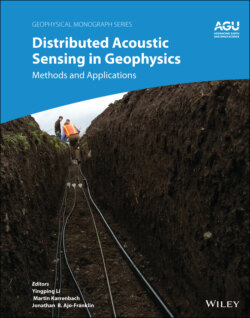Читать книгу Distributed Acoustic Sensing in Geophysics - Группа авторов - Страница 36
2.1. INTRODUCTION
ОглавлениеThe exciting and rapidly evolving technology of DAS, which uses optical fibers to sense local changes in strain, acquires seismic data for many applications, such as vertical seismic profiling (VSP) (Barfoot, 2013; Mestrayer et al., 2011; Mateeva et al., 2017), earthquake monitoring (Martin et al., 2017), hydraulic‐fracture geometry characterization (Jin & Roy, 2017), and microseismic monitoring (Hull et al., 2017). Improvements in the interrogator design (Hartog, 2017) and deployment methods (Ellmauthaler et al., 2020) have increased the signal‐to‐noise ratio (SNR) of the raw measurements, while processing improvements (Ellmauthaler et al., 2017; Chen et al., 2019; Willis et al., 2020) have allowed the removal of specific fiber‐optic noise patterns in the data.
Acquiring seismic data using accelerometers, geophones, and seismometers is a well‐developed and understood practice. Ironically, because it is so common, we rarely stop to question the actual field hardware used to acquire data or the software to process it; thus, it is frequently treated as a trusted commodity. In contrast, DAS technology is not as widely understood by the geophysics community, just as the requirements and applications of seismic data might not be generally grasped by fiber‐optic engineers and physicists who build and maintain DAS hardware and software. This situation creates the potential for degradations in the quality of seismic data acquired by DAS. This chapter describes the practical aspects for obtaining quality borehole seismic data using DAS to bridge the gap between fiber‐optic technologists and the geophysics community.
